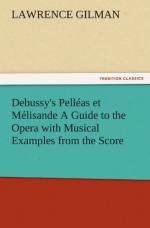As Golaud bends with Arkel over the unconscious figure of Melisande where she lies stretched upon her bed, muted horns and ’cellos play a gentle variant of the Fate theme, followed by the Melisande motive as Golaud exclaims that they had but “kissed like little children.” The theme of Pity accompanies Melisande’s awakening, and a new motive is heard as she responds, to Arkel’s question: “I have never been better.” This new theme (page 274, measure 4), of extraordinary poignancy, is given out by an oboe supported by two flutes, and its expression is marked triste et tres doucement expressif. I shall call it the motive of Sorrow, for it seems like the comment of the music upon the transporting and utter sadness of the play’s denouement. It voices a gentle and passive commiseration, rather than a profound and shaking grief:
XXIII. SORROW
[Illustration: Lent et triste]
A third new theme, also of searching pathos, occurs in the strings, p, tres doux, as Melisande quietly greets her husband (page 279, measure 1), and later, when she says that she forgives him (page 282, measure 1). It may be called the motive of Melisande’s Gentleness:
XXIV. MELISANDE’S GENTLENESS
[Illustration: tres doux]
As Golaud’s still unvanquished doubts and suspicions torture him into harsh interrogations, and he asks her if she loved Pelleas “with a forbidden love,” an oboe and two flutes recall, p et doux, the Rapture motive. Later, in succession, we hear (on a solo violin over flute and clarinets) the Pelleas theme (page 289, measure 2), the motive of Gentleness, for the last time (page 290, measure 3), and the Melisande theme (pages 290-292). As Melisande recognizes Arkel, and asks if it be true “that the winter is coming,” a solo violin, solo ’cello, and two clarinets play an affecting phrase (page 294, measure 5). She tells Arkel that she does not wish the windows closed until the sun has sunk into the sea, and the orchestra accompanies her in a passage of curiously delicate sonority (page 295, measure 6).
The final scene of the act is treated with surpassing reticence, dignity, and simplicity, yet with piercing intensity of expression. Nothing could be at the same time more sparing of means and more exquisitely eloquent in result than Debussy’s setting of the scene of Melisande’s death—it is music which dims the eyes and subdues the spirit. The pianissimo-repeated chords in the divided strings which accentuate Arkel’s warning words (page 304, measure 8); the blended tones of the harp and the distant bell at the moment of dissolution (page 306, measure 11); Arkel’s simple requiem over the body of the little princess, with the grave and tender orchestral commentary woven out of familiarly poignant themes (pages 308-309); the murmurous coda, with its muted trumpet singing a gentle dirge under an accompaniment of two flutes (page 310, measure 7),—these things are easy to




